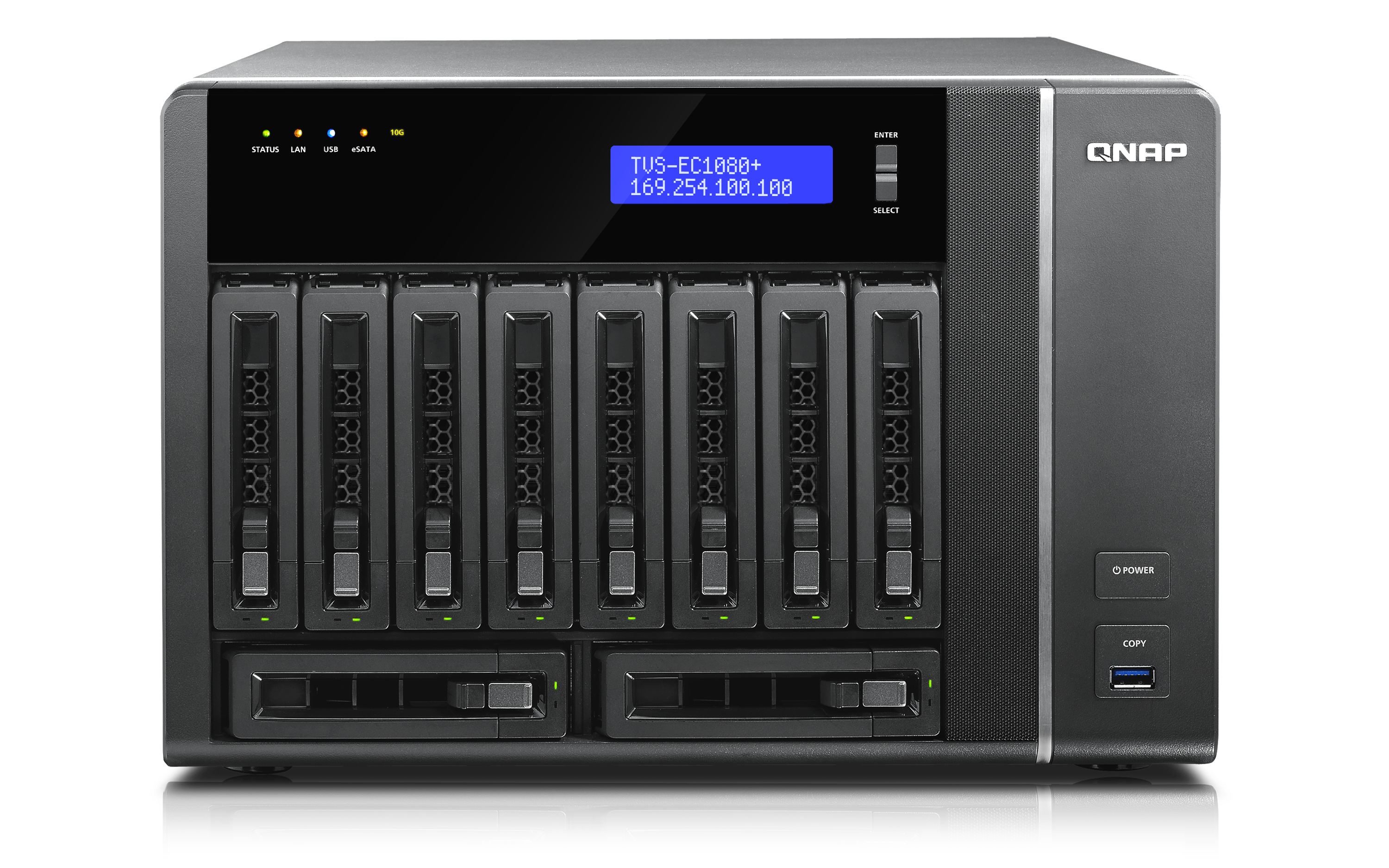Our Verdict
Exceptional performance if you have the setup. Onboard SSD caching and 10GbE support round out an all-star NAS if you have the funds.
PC Gamer's got your back
A NAS for the power hungry
There are NASes, and then there are uber-NASes. The QNAP TVS-EC1080+ is one such uber-NAS. Pitched as an enterprise-level unit, the TVS-EC1080+ packs in killer hardware features, as well as a host of applications that users should find useful.
At times, we find that some of QNAP's NAS units can be a bit confusing. Like the TVS-871 that we reviewed not long ago, it's sometimes hard to see the clear lines between enterprise and consumer. There are a lot of features in both units that are clearly targeted toward consumers, although they don't have to be used. If we focus purely on pricing though, the TVS-EC1080+ is definitely a business appliance. At $3,300, we suspect that few home users would consider the TVS-EC1080+, except for the few that feel they must have only the best.
So, what does a $3,300 NAS get you?
THE QNAP TVS-EC1080+
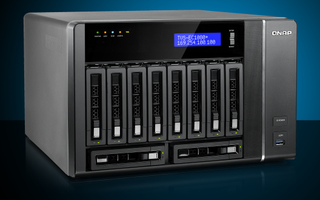
| Row 0 - Cell 0 | QNAP TVS-EC1080+ Specifications |
| Storage Management | Single disk, JBOD, RAID 0, 1, 5, 6, 10, 5 + hot spareOnline volume expansionOnline RAID capacity expansionOnline RAID level migrationGlobal hot spareStorage expansion via QNAP UX-500P / UX-800PBad block scan and hard drive S.M.A.R.T.Bad block recoveryRAID recoveryBitmap support |
| CPU | Intel Xeon E-1245 v3 3.4GHz Quad Core |
| Memory | 32GB DDR3 (4 x 8GB DIMM) |
| SSD Cache | 256GB (128GB x 2) mSATA SSD |
| HDD | 10 bays (8TB drive support) |
| Video | HDMI |
| Network | 2x 10GbE, 4x 1Gb Ethernet |
| USB | 3x USB 3.0 (one front), 6x USB 2.0Supports USB printer, drive, USB hub, UPS |
| Cooling | 2x 120mm rear exhaust |
| Power | 350W |
| Expansion | 1x PCIe Gen 3 x8 slot for 10GbE (pre-installed)2x eSATA ports (rear) |
| Dimensions | 217.5 (H) x 327.0 (W) x 321.2 (D) mm8.56 (H) x 12.8 (W) x 12.65 (D) inches |
| Weight | 12.52 kg / 27.61.26 lbs (without drives) |
| OS | QTS 4.2 embedded Linux |
| Extras | 2x CAT6, 4x CAT5e Ethernet cables |
The specifications speak for themselves.
Small- to medium-sized offices would find the TVS-EC1080+ useful, especially with its large capacity support and integrated 10GbE support. The primary function overall for the TVS-EC1080+ is to serve files, and serve them fast.
In a business environment, most of the software features in the TVS-EC1080+ will not be used. Photo backup, photo serving, torrent downloading, and media playback are some of the consumer features available to you out of the box, but we're far more interested in the performance that the TVS-EC1080+ brings to bear.
QNAP designed the TVS-EC1080+ with integrated SSD caching in the form of not just one, but two 128GB mSATA SSDs. Customers are able to install SSDs to four more bays and use them as caching drives for the most performance-demanding usage scenarios.
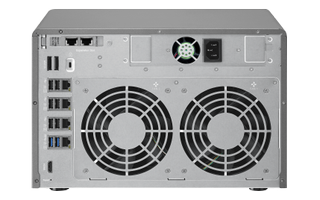
We configured our TVS-EC1080+ with equally impressive drives from HGST in the form of the Ultrastar He8 8TB helium drives. HGST offers the Ultrastar He8 in both SATA and SAS, but the TVS-EC1080+ only supports SATA. The Ultrastar He8 drives are fast and offer copious amounts of capacity, and are perfect for a NAS such as this.
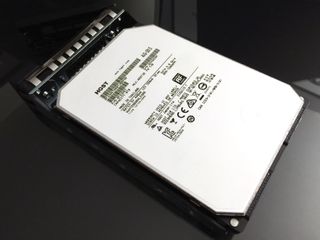
Why didn't we go with "NAS" drives? Well, the Ultrastar He8 drives are designed for environments such as this, as well as rack-mounted applications. Enterprise NAS drives have optimized firmware, high-grade components, longer warranties, and features such as top- and bottom-mounted spindle motors to increase rigidity and decrease vibrations. The Ultrastar He8 drives are no exception.
HGST's use of helium in its drives also decreases internal turbulence and air friction, and the second generation He models deliver the same performance as other drives in their class but with roughly 23 percent decrease in energy use. Businesses using multiple NASes, or racks full of drives will appreciate the power savings over the long run.
We filled all 10 bays with HGST Ultrastar He8 drives for a total raw capacity of 80TB. Any more drives and it would have floated away.

GETTING THINGS UP AND RUNNING
The TVS-EC1080+ is no more difficult to set up and use than any of the other NASes in QNAP's line-up, and it operates much in the same fashion as the TVS-881 we previously reviewed. The following setup portion was taken from our TVS-871 review:
We simply installed the hard drives into their cages, and plugged them in. You're able to configure the storage array via the built-in HDMI interface or by logging in to its web interface. We opted for setup using the web interface, since there's only so much you can do with the two-line built-in display.
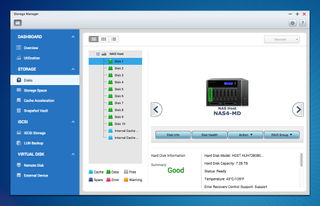
Upon login and the obligatory administration setup, we immediately configured the TVS-EC1080+ to RAID 6. The system recommended RAID 6 by default, but you're able to choose whatever RAID level you desire. On a NAS like this, there's really no point in using RAID 0, since performance won't be realized over 1Gb Ethernet, and you'll want some sort of redundancy. At our 80TB of total system capacity, RAID 1 would get you 40TB and allow up to four drive failures before complete catastrophe, but halving our total capacity seemed wasteful.
We went with RAID 6 because you get the best combination of performance, redundancy, and capacity. RAID 6 is essentially like RAID 5, but with support for double drive failures. With RAID 6 configured, we were left with a total usable capacity of 57.09TB.
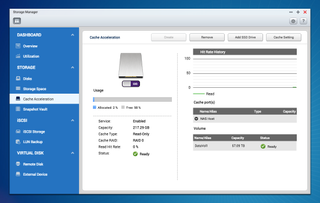
Special to the TVS-EC1080+ is onboard SSD caching. The TVS-EC1080+ utilizes two 128GB mSATA drives, in this case from ADATA to act as one 256GB cache volume in RAID 0. Frequently accessed data will be allocated to the SSD volume for faster access. Keep in mind, though, that this is for read operations only. Write operations go directly to disk.
Because we filled up all the drive bays in the TVS-EC1080+ for the array, no drives were left to act as a hot-spare.
If you're interested in reading the features of QNAP's management system, check out that section in our TVS-871 review, as they're identical on the TVS-EC1080+.
Tests
We tested several features of the TVS-EC1080+, including RAID fail, and throughput. We used a 10GbE dual-port NIC from Small Tree for our testbed.
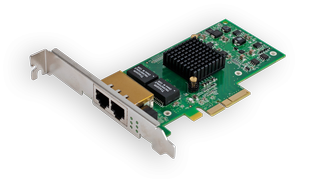
Note that we used four Samsung 850 Pro 1TB in RAID 0 in order to further test the 10GbE performance of the TVS-EC1080+. We also used the Netgear ProSAFE XS708E switch and configured link aggregation to perform our tests over an aggregated link of 20GbE.
Tests were done with the following hardware:
| Row 0 - Cell 0 | Test bed |
| Motherboard | ASUS Rampage IV Black Edition |
| CPU | Intel Core i7 3970X |
| RAM | Samsung "Green" DDR3 32GB |
| SSD | Samsung 850 Pro 1TB 4x (RAID 0) |
| OS | Windows Server 2012 R2 |
| NIC | Small-Tree Dual Port 10GBASE-T P2E10G-2-T |
| Switch | Netgear ProSAFE XS708E 10GbE |
| Router | ASUS RT-AC87U AC2400 |
| Cable | CAT6 10 ft |
Note: Thanks to CyberPower PC for supplying the Samsung 850 Pro 1TB SSDs!
THE BENCHMARKS:
| Test | Score |
| File Copy Write RAID 0 | 1,781.3 MB/sec |
| File Copy Read RAID 0 | 1,797.2 MB/sec |
| File Copy Write RAID 5 | 1,567.1 MB/sec |
| File Copy Read RAID 5 | 1,686.6 MB/sec |
| File Copy Write RAID 6 | 1,559.0 MB/sec |
| File Copy Read RAID 6 | 1,564.7 MB/sec |
| File Copy Write RAID 10 | 939.5 MB/sec |
| File Copy Read RAID 10 | 1,729.3 MB/sec |
From the chart above, we see the numbers are thoroughly impressive. There are plenty of usage models that could take advantage of the available performance. Multi-user setups are well suited for such high-bandwidth-capable NASes, virtualization, and iSCSI. For attached storage at this performance level, iSCSI becomes an interesting proposition, as it allows you to configure a volume on the NAS as a block-level mount. You're able to format and mount a volume as if it were local storage.
For those who are interested in knowing, the HGST Ultrastar He8 performs admirably as well, reaching 207MB/s reads and writes as a single drive. This is largely due to the incredible aerial density that comes with being an 8TB drive. The best part of it is, the He8 is an enterprise drive with respective quality components as well as warranty. Again, we thoroughly recommend you go with enterprise-grade drives.
Comparing our results with QNAP's own tests, which we've verified to be quite accurate, we see that we can get even more performance out of the TVS-EC1080+ with the right kind of setup.
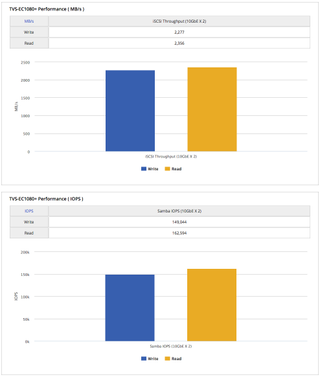
Note: QNAP utilized a RAID 5 array in its benchmarks, which is less taxing than running a RAID 6 array due to the NAS having to compute half the parity. However, RAID 6 can withstand two drive failures while RAID 5 can only take one, and judging from our own RAID 6 vs. RAID 5 benchmarks, the decrease in performance is small enough that we'll gladly take another drive parity.
For those seeking to approach QNAP's benchmarks numbers, you'll more than likely want to use SSD drives. You can attain top speeds too, provided that you have the right network and client station setups. We had to use link aggregation with an appropriate switch.
A beast for SMB or insane home user
Like the TVS-871 before it, the TVS-EC1080+ is more than you can ask for in a NAS. Compared to other similarly priced models from competitors, you're getting a lot for your money.
We did encounter a few minor issues while working with QNAP's backup station, though. For example, syncing would at times fail, and while backing up from client PCs, there were times when both Windows and OS X's Time Machine would fail to detect the NAS. Retrying would solve the issue, but it would still happen from time to time.
Where do we see the TVS-EC1080+ fitting into a business? For large-scale enterprises, rack servers are the way, and while SMBS will find the TVS-EC1080+ very powerful, smaller studios will find the NAS incredibly useful as well. Media production studios that are growing beyond single-digit client stations could really benefit from the scalability that the TVS-EC1080+ offers. Large amounts of usable capacity, exceptional performance, and 10GbE support allows the TVS-EC1080+ to grow as your business needs grow.
So, where does this leave the home user? Simply put, the TVS-EC1080+ is absolutely overkill for home use. Xeon processers not withstanding, it's incredibly difficult for a home environment to take advantage of the hardware that's inside the TVS-EC1080+. But if you must have an uber-NAS, the TVS-EC1080+ is one such option.
Exceptional performance if you have the setup. Onboard SSD caching and 10GbE support round out an all-star NAS if you have the funds.
